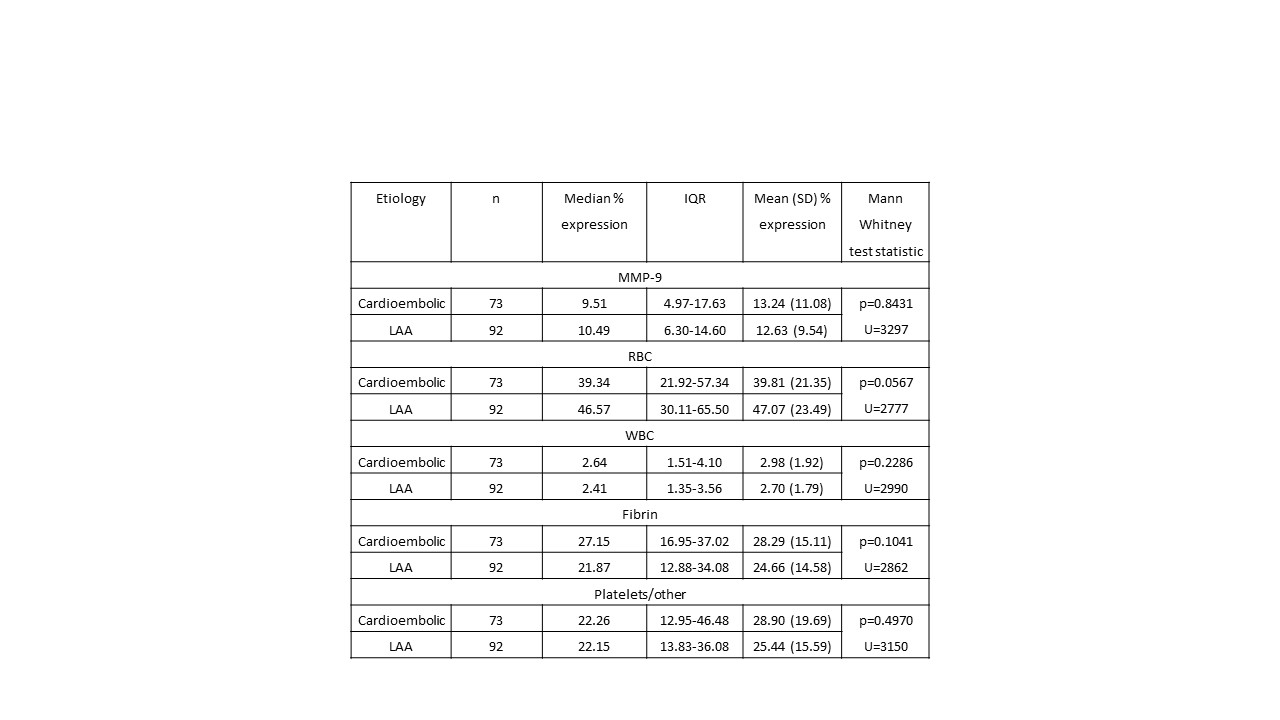Introduction The matrix metalloproteinase MMP-9 is involved in the integrity of the vascular wall. MMP-9 degrades denatured collagens, several types of native collagens as well as other extracellular matrix substrates such as laminin. As such they can degrade the basal lamina surrounding capillaries which contain collagen type IV, fibronectin and laminin. Neutrophil infiltration into infarcted and haemorrhagic tissue along with elevated neutrophil derived MMP-9 expression has also been associated with basal lamina collagen IV degradation leading to blood-brain barrier breakdown. We hypothesised that MMP-9 would be a component within the clots that cause acute ischaemic strokes and that there may be a potential difference in MMP-9 expression levels in AIS clots based on stroke etiology (cardioembolic v large artery atherosclerosis (LAA)). Methods Clots from 100 AIS patients (165 passes) were collected. These were separated based on etiology into two groups, Cardioembolic (50 cases, 73 passes) and LAA (50 cases, 92 passes). Immunohistochemical staining was performed on 3µm sections for MMP-9 on a Leica Bond III autostainer. Histological staining for red blood cells (RBC), white blood cells (WBC), fibrin and platelets/other components was performed using Martius Scarlet Blue (MSB) stain. Images were scanned using an Olympus VS120 slide scanner. Quantification analysis to determine percentage expression was performed using Orbit Image Analysis software. Data was not normal therefore the non-parametric Mann-Whitney test was used for statistical analysis (Graphpad 8). Immunofluorescence was used to determine co-localisation of MMP-9 with key clot components, neutrophils (CD66b), fibrin, lymphocytes (CD3), red blood cells (GlyA), platelets (CD42b), neutrophil extracellular traps (NETs) (histone H3). Results Descriptive statistics and the Mann-Whitney test statistics are reported in table1. Table 1: Descriptive statistics for MMP-9, RBC, WBC, fibrin and platelets/other for cardioembolic and LAA clots. Non-parametric statistics by Mann-Whitney test for comparison of components across etiologies. There was a strong trend indicating that content of cardioembolic clots were lower in RBC’s and higher in fibrin which is in agreement with published data. There was considerable expression of MMP-9 in AIS clots, however there was no significant difference in MMP-9 expression in AIS clots of cardioembolic and LAA etiologies. Co-localisation studies showed that WBC’s, specifically neutrophils were the main component in AIS clots that expressed MMP-9. There was also some evidence of MMP-9 in NET’s. MMP-9 expression did not co-localise with RBC’s, fibrin or platelets. Conclusion No significant difference in MMP-9 expression levels was observed between Cardioembolic and LAA. There was no significant difference in WBC’s according to etiology. LAA clots were richer in RBC’s but lower in fibrin and platelets. Co-localisation studies showed that neutrophils were the main source of MMP-9 in AIS clots. Although MMP-9 is expressed to a significant extent in AIS clots, the level of expression is not connected to etiology.
Physiology 2021 (2021) Proc Physiol Soc 48, PC086
Poster Communications: Matrix metalloproteinase-9 expression levels in acute ischaemic stroke (AIS) clots of different etiologies.
Andy Douglas1, 2, Madalina Mereuta1, 2, Rosanna Rossi1, 2, Duaa Jabrah1, Sean Fitzgerald1, Abhay Pandit2, Michael Gilvarry3, Ray McCarthy3, Klearchos Psychogios4, Istvan Szikora5, Jack Alderson6, Paul Brennan6, Sarah Power6, John Thornton6, Katarina Jood7
1 Department of Physiology, School of Medicine, National University of Ireland, Galway, Galway, Ireland 2 CÚRAM–Centre for Research in Medical Devices, National University of Ireland Galway, Galway, Ireland 3 Cerenovus, Galway, Ireland 4 Metropolitan Hospital, Department of Neuroradiology, Piraeus, Greece 5 National Institute of Clinical Neurosciences, Department of Neurointerventions, Budapest, Hungary 6 Department of Radiology, Royal College of Surgeons in Ireland, Beaumont Hospital, Dublin, Ireland 7 Department of Neurology, Sahlgrenska University Hospital, Gothenburg, Sweden 8 Department of Interventional and Diagnostic Neuroradiology, Sahlgrenska University Hospital, Gothenburg, Sweden
View other abstracts by:
Where applicable, experiments conform with Society ethical requirements.

